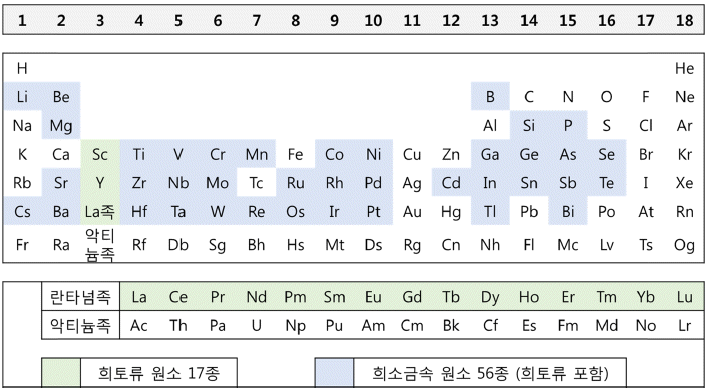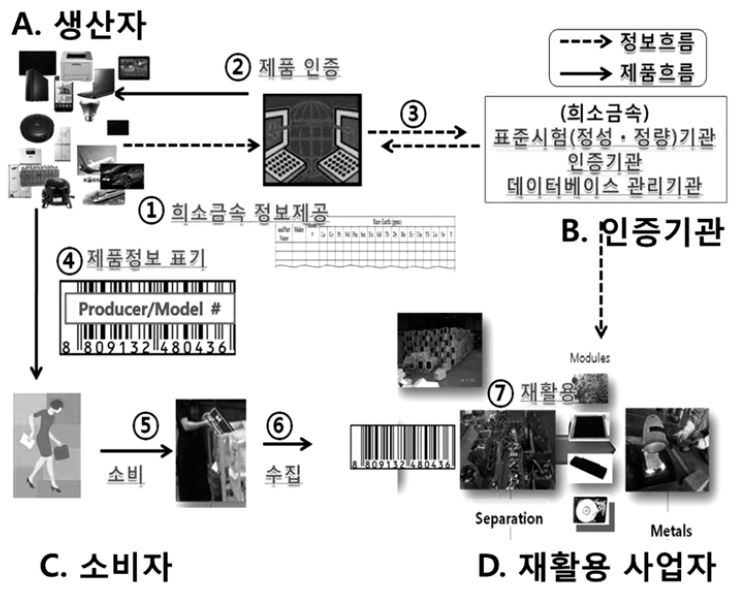Search
- Page Path
- HOME > Search
- [Korean]
- Standardization Status of Rare Earth Elements Recycling in ISO TC 298
- Mi Hye Lee, Yosep Song, Ji Sun On, Seung Hwan Yoon, Munhwan Han, Bum Sung Kim, Taek-soo Kim, Bin Lee
- J Powder Mater. 2022;29(2):159-165. Published online April 1, 2022
- DOI: https://doi.org/10.4150/KPMI.2022.29.2.159

- 941 View
- 24 Download
-
 Abstract
Abstract
 PDF
PDF Rare earth elements, which are important components of motors, are in high demand and thus constantly get more expensive. This tendency is driven by the growth of the electric vehicle market, as well as environmental issues associated with rare-earth metal manufacturing. TC 298 of the ISO manages standardization in the areas of rare-earth recycling, measurement, and sustainability. Korea, a resource-poor country, is working on international standardization projects that focus on recycling and encouraging the domestic adoption of international standards. ITU-T has previously issued recommendations regarding the recycling of rare-earth metals from e-waste. ISO TC 298 expands on the previous recommendations and standards for promoting the recycling industry. Recycling-related rare earth standards and drafts covered by ISO TC 298, as well as Korea’s strategies, are reviewed and discussed in this article.
- [Korean]
- Standardization of Rare Earth Elements in ISO TC 298 and Korea's Standardization Strategy
- Nu Si A Eom, Sardar Farhat Abbas, Haq Muhammad Aneeq, Rasheed Mohammad Zarar, Mi Hye Lee, Bum Sung Kim, Taek-Soo Kim, Bin Lee
- J Korean Powder Metall Inst. 2019;26(3):251-257. Published online June 1, 2019
- DOI: https://doi.org/10.4150/KPMI.2019.26.3.251

- 827 View
- 3 Download
-
 Abstract
Abstract
 PDF
PDF Since the ISO decided to deal with rare-earth elements at the 298th Technical Committee (TC) in 2015, Korea has participated in four plenary meetings and proposed four standards as of June 2019. The status of ISO TC 298, the standards covered by the TC, and the standardization strategies of Korea are summarized. Korean delegations are actively engaged in WG2, which deals with recycling, proposing four standards for fostering the rare-earth recycling industry. However, the participation of domestic experts is still low compared with the increase in the number of working groups and the number of standards in TC 298. The aim of this article is to summarize the current status of ISO international standards related to rare-earth elements, to encourage relevant experts to participate in standardization, and to develop international standards that accurately reflect the realities of the industry.
- [Korean]
- Status of ITU-T International Standard Development on Rare Metal Recycling
- Mi Hye Lee, Won Jung Choi, Seok-Jun Seo, Bum Sung Kim
- J Korean Powder Metall Inst. 2016;23(4):325-330. Published online August 1, 2016
- DOI: https://doi.org/10.4150/KPMI.2016.23.4.325

- 628 View
- 1 Download
- 3 Citations
-
 Abstract
Abstract
 PDF
PDF Owing to increasing demand of rare metals present in ICT products, it is necessary to promote the rare metal recycling industry from an environmental viewpoint and to prevent climate change. Despite the fact that information for toxic substances is partly indicated, a legal basis and an international standard indicating usage of rare metals is insufficient. In order to address this issue, a newly created study group of environment and climate change at the ITU (International Telecommunication Union) is doing research to develop methodologies for recycling rare metals from ICT products in an eco-friendly way. Under this group, the Republic of Korea has established two international standards related to rare metals present in ICT products. The first is ‘Release of rare metal information for ICT products (ITU-T L.1100)’ and the other is ‘Quantitative and qualitative analysis methods for rare metals (ITU-T L.1101)’. A new proposal for recommending the provision of rare metal information through a label by manufacturers and consumer/recycling businesses has been approved recently and is supposed to be published later in 2016. Moreover, these recommendations are also being extended to IEC, ISO and other standardization organizations and a strategy to reinforce the ability for domestic standardization is being established in accordance with industrial requirements. This will promote efficient recycling of rare metals from ICT products and will help improve the domestic supply of rare metals.
-
Citations
Citations to this article as recorded by- The State of Affairs of ‘Rare Metal Industry’ in Korea
Jae Hong Shin, Lee Ro Woon, Kyoung Tae Park
Kompleksnoe Ispolʹzovanie Mineralʹnogo syrʹâ/Complex Use of Mineral Resources/Mineraldik Shikisattardy Keshendi Paidalanu.2024; 330(3): 43. CrossRef - Russian Mineral Market Flow and Economic Direction for Securing Stable Resources
Nu Si A Eom, Su Noh, Muhammad Aneeq Haq, Bin Lee, Kyoung Mook Lim, Bum Sung Kim
Journal of Korean Powder Metallurgy Institute.2019; 26(4): 345. CrossRef - Trends and Implications of International Standardization for Rare Earths
Sardar Farhat Abbas, Sang-Hyun lee, Bin Lee, Bum-Sung Kim, Taek-Soo Kim
Journal of Korean Powder Metallurgy Institute.2018; 25(2): 165. CrossRef
- The State of Affairs of ‘Rare Metal Industry’ in Korea
TOP
 kpmi
kpmi


 First
First Prev
Prev


